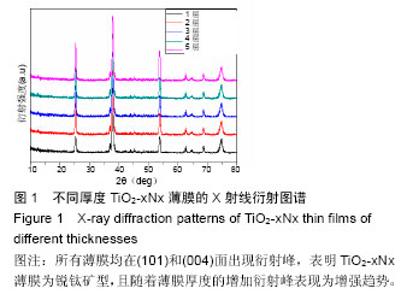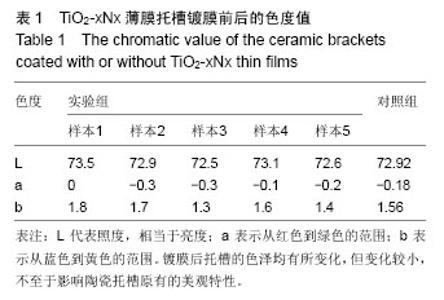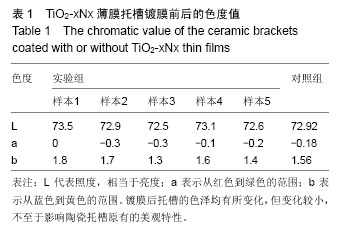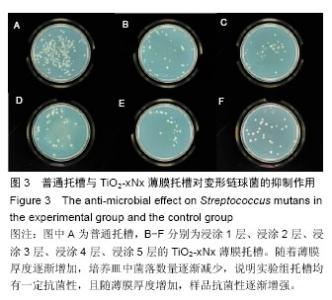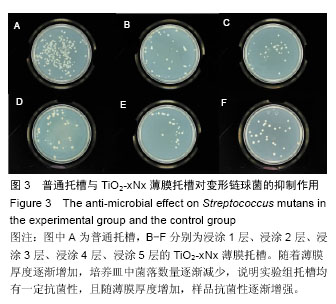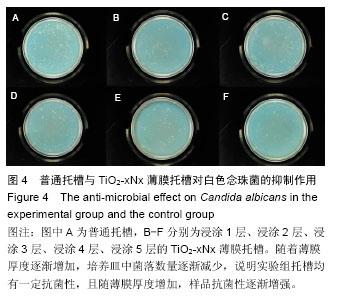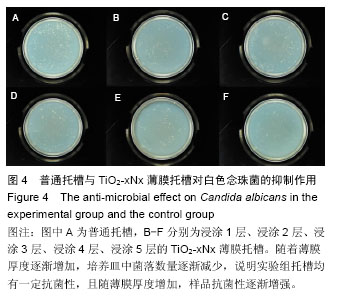Chinese Journal of Tissue Engineering Research ›› 2016, Vol. 20 ›› Issue (34): 5039-5044.doi: 10.3969/j.issn.2095-4344.2016.34.004
Previous Articles Next Articles
TiO2-xNx thin films on ceramic bracket surfaces: preparation and antibiotic performance
Wang Jian-wei, Wang Yu, Che Yuan-qian, Zhu Bo-wu, Cao Bao-cheng
- School of Stomatology, Lanzhou University, Lanzhou 730000, Gansu Province, China
-
Received:2016-07-09Online:2016-08-19Published:2016-08-19 -
Contact:Cao Bao-cheng, Professor, School of Stomatology, Lanzhou University, Lanzhou 730000, Gansu Province, China -
About author:Wang Jian-wei, Attending physician, School of Stomatology, Lanzhou University, Lanzhou 730000, Gansu Province, China -
Supported by:the Natural Science Foundation of Gansu Province, No. 1208RJZA236
CLC Number:
Cite this article
Wang Jian-wei, Wang Yu, Che Yuan-qian, Zhu Bo-wu, Cao Bao-cheng. TiO2-xNx thin films on ceramic bracket surfaces: preparation and antibiotic performance[J]. Chinese Journal of Tissue Engineering Research, 2016, 20(34): 5039-5044.
share this article

2.2 扫描电镜分析结果 图2为500 ℃退火后1-5层薄膜经扫描电镜放大5万倍后的表面形貌,如图所示,所制备的薄膜光滑、完整且晶粒微细致密、均匀分布。随着浸泡次数的增加,涂层表面形貌更加致密,裂纹减少。2.3 薄膜附着力检测结果 薄膜附着力指薄膜对衬底黏着能力的大小,即薄膜与衬底材料在化学键合力或物理咬合力作用下的黏结强度[19-20]。 随机抽取5个浸涂5层的样品,每个样品随机测试3个不同部位,最终取5组附着力的平均值得薄膜的最终附着力,为18.37 N。TiO2-xNx薄膜托槽带入口腔后,会受到刷牙、食物摩擦、弓丝摩擦等,由于薄膜与衬底托槽为不同材料,因此附着力的强弱直接影响薄膜材料的性能。影响薄膜附着力的因素很多, 包括靶材、基底的材料, 前处理、制备工艺及后处理等[21],受制备工艺的影响,虽然附着力仅为18.37 N,但足以承受在口腔正常应用中所受到的摩擦[22]。"

| [1] Bishara SE,Fehr DE.Ceramic brackets: Something old, something new, a review. Seminars in Orthodontics. 1997;3(3):178-188. [2] Eliades T,Lekka M,Eliades G,et al. Surfacecharacterization of ceramic brackets: a multitechnique approach.Am J Orthod Dentofac Orthop.1994;105(1):10-14 [3] Chang HS,Walsh LJ,Freer TJ.Enamel demineralization during orthodontic treatment. Aetiology and prevention. Aust Dent J.1997;42(5):322-327. [4] Mizrahi E.Enamel demineralization following orthodontic treatment.Am J Orthod. 1982;82(1):62-67. [5] Chatterjee R,Kleinberg I.Effect of orthodontic band placement on the chemical composition of human incisor tooth plaque.Arch Oral Biol.1979;24(2):97-100. [6] Richter AE,Arruda AO,Peters MC,et al.Incidence of caries lesions among patients treated with comprehensive orthodontics.Am J Orthod Dentofac Orthop.2011;139(5):657-664. [7] Frey C,Yetkiner E,Stawarczyk B,et al.Effects of different chlorhexidine pretreatments on adhesion of metal brackets in vitro.Head Face Med.2012;8(36):1-5. [8] Li F,Weir MD,Chen J,et al.Comparison of quaternary ammonium- containing with nano- silver- containing adhesive in antibacterial properties and cytotoxicity. Dent Mater.2013;29(4):450- 461. [9] 张晟,麦理想,柳大烈,等.纳米Ag/ TiO2 涂层托槽的研制及力学性能[J].中国组织工程研究, 2012,16(38):7047-7052. [10] Grigorov KG,Oliveira IC,Maciel HS,et al.Optical and morphological properties of N-doped TiO2 thin films. Surf Sci.2011;605(7):775-782. [11] Mattsson A,Lejon C,Bakardjieva S,et al. Characterisation, phase stability and surface chemical properties of photocatalytic active Zr and Y co-doped anatase TiO2 nanoparticles.J Solid State Chem. 2013; 199:212-223. [12] Di Valentin C,Finazzi E,Pacchioni G,et al.N-doped TiO2: Theory and experiment.Chem Phys. 2007;339: 44-56. [13] Jiang X,Wang Y,Pan C.High Concentration Substitutional N-Doped TiO2 Film: Preparation, Characterization, and Photocatalytic Property.J Am Ceram Soc. 2011;94(11):4078-4083. [14] 李娜,曹宝成,王育华,等.掺氮TiO(2-x)Nx薄膜托槽的制备及其性能研究[J].功能材料,2011,42(B11):835-838. [15] Li S,Hobson RS,Bai Y,et al.A method for producing controlled fluoride release from an orthodontic bracket. EurJ Orthod.2007;29(6):550-554. [16] 束嫘,丁寅,曹勇,等.纳米陶瓷涂层托槽的研制[J].实用口腔医学杂志,2005, 21(2):252-255. [17] Meng FM,Lu F.Chracterization and PhotocataIytic Activity of TiO2 Thin Films Prepared by RF Magnetron sputtering.Vacuum.2010;85(1):84-88. [18] Studenikin SA,Golego N,Cocivera M.Carrier mobility and density contributions to photoconductivity transients in polycrystalline ZnO films.J Appl Phys. 2000;87:2413. [19] Pradhan SS,Sahoo S,Pradhan SK.Influence of Annealing Temperatture on the Structual, Mechanical and Wetting Properyt of TiO2 Film Deposited by RF Magnetron Sputtering. Thin Solid Films. 2010;518(23):6904-6908. [20] 唐伟忠.薄膜材料制备原理、技术及应用[M].北京:冶金工业出版社,2003. [21] 田明波.薄膜技术与薄膜材料[M].北京:清华大学出版社, 2006:247-253. [22] Kilicoglu H,Yildirim M,Polater H.Comparison of the effectiveness of two types of toothbrushes on the oral hygiene of patients undergoing orthodontic treatment w ith fixed appliances.Am J Orthod Dentofacial Orthop. 1997;111(6):591-594 . [23] Cal E,Güneri P,Kose T.Comparison of digital and spectrophotometric measurements of colour shade guides.J Oral Rehabil.2006;33(3):221-228. [24] Shungin D,Olsson AI,Persson M.Orthodontic treatment-related white spot lesions: a 14- year prospective quantitative follow- up,including bonding material assessment. Am J Orthod Dentofacial Orthop.2010;138(2):136e1-8. [25] Asahi R,Morikawa T,Ohwaki T,et al.Visible-Light Photocatalysis in Nitrogen-Doped Titanium Oxides. Science.2001;293(5528):269-271. [26] Bu X,Zhang G,Zhang C.Effect of nitrogen doping on anatase–rutile phase transformation of TiO2.Appl Surf Sci. 2012;258(20):7997-8001. [27] O'reilly M,Featherstone J.Demineralization and remineralization around orthodontic appliances: an in vivo study.Am J Orthod Dentofacial Orthopedics. 1987;92(1):33-40. [28] Lemos JA,Quivey RG,JrKoo H,et al.Streptococcus mutans: a new Gram-positive paradigm? Microbiology. 2013;59(Pt 3):436-445. [29] 闫文娟,杨德鸿,吴补颌.变形链球菌8cp基因突变菌株的构建及鉴定[J].中华老年口腔医学杂志, 2011,9(6):325-328 [30] Kleinegger CL,Lockhard SR,Vargas K,et al.Frequency, intensity species, and strainsofora Candida vary as a function of hostage.J Clin Microbiol.1996; 30(1): 2246-2254. |
| [1] | Chen Ziyang, Pu Rui, Deng Shuang, Yuan Lingyan. Regulatory effect of exosomes on exercise-mediated insulin resistance diseases [J]. Chinese Journal of Tissue Engineering Research, 2021, 25(25): 4089-4094. |
| [2] | Chen Yang, Huang Denggao, Gao Yuanhui, Wang Shunlan, Cao Hui, Zheng Linlin, He Haowei, Luo Siqin, Xiao Jingchuan, Zhang Yingai, Zhang Shufang. Low-intensity pulsed ultrasound promotes the proliferation and adhesion of human adipose-derived mesenchymal stem cells [J]. Chinese Journal of Tissue Engineering Research, 2021, 25(25): 3949-3955. |
| [3] | Yang Junhui, Luo Jinli, Yuan Xiaoping. Effects of human growth hormone on proliferation and osteogenic differentiation of human periodontal ligament stem cells [J]. Chinese Journal of Tissue Engineering Research, 2021, 25(25): 3956-3961. |
| [4] | Sun Jianwei, Yang Xinming, Zhang Ying. Effect of montelukast combined with bone marrow mesenchymal stem cell transplantation on spinal cord injury in rat models [J]. Chinese Journal of Tissue Engineering Research, 2021, 25(25): 3962-3969. |
| [5] | Gao Shan, Huang Dongjing, Hong Haiman, Jia Jingqiao, Meng Fei. Comparison on the curative effect of human placenta-derived mesenchymal stem cells and induced islet-like cells in gestational diabetes mellitus rats [J]. Chinese Journal of Tissue Engineering Research, 2021, 25(25): 3981-3987. |
| [6] | Hao Xiaona, Zhang Yingjie, Li Yuyun, Xu Tao. Bone marrow mesenchymal stem cells overexpressing prolyl oligopeptidase on the repair of liver fibrosis in rat models [J]. Chinese Journal of Tissue Engineering Research, 2021, 25(25): 3988-3993. |
| [7] | Liu Jianyou, Jia Zhongwei, Niu Jiawei, Cao Xinjie, Zhang Dong, Wei Jie. A new method for measuring the anteversion angle of the femoral neck by constructing the three-dimensional digital model of the femur [J]. Chinese Journal of Tissue Engineering Research, 2021, 25(24): 3779-3783. |
| [8] | Meng Lingjie, Qian Hui, Sheng Xiaolei, Lu Jianfeng, Huang Jianping, Qi Liangang, Liu Zongbao. Application of three-dimensional printing technology combined with bone cement in minimally invasive treatment of the collapsed Sanders III type of calcaneal fractures [J]. Chinese Journal of Tissue Engineering Research, 2021, 25(24): 3784-3789. |
| [9] | Qian Xuankun, Huang Hefei, Wu Chengcong, Liu Keting, Ou Hua, Zhang Jinpeng, Ren Jing, Wan Jianshan. Computer-assisted navigation combined with minimally invasive transforaminal lumbar interbody fusion for lumbar spondylolisthesis [J]. Chinese Journal of Tissue Engineering Research, 2021, 25(24): 3790-3795. |
| [10] | Hu Jing, Xiang Yang, Ye Chuan, Han Ziji. Three-dimensional printing assisted screw placement and freehand pedicle screw fixation in the treatment of thoracolumbar fractures: 1-year follow-up [J]. Chinese Journal of Tissue Engineering Research, 2021, 25(24): 3804-3809. |
| [11] | Shu Qihang, Liao Yijia, Xue Jingbo, Yan Yiguo, Wang Cheng. Three-dimensional finite element analysis of a new three-dimensional printed porous fusion cage for cervical vertebra [J]. Chinese Journal of Tissue Engineering Research, 2021, 25(24): 3810-3815. |
| [12] | Wang Yihan, Li Yang, Zhang Ling, Zhang Rui, Xu Ruida, Han Xiaofeng, Cheng Guangqi, Wang Weil. Application of three-dimensional visualization technology for digital orthopedics in the reduction and fixation of intertrochanteric fracture [J]. Chinese Journal of Tissue Engineering Research, 2021, 25(24): 3816-3820. |
| [13] | Sun Maji, Wang Qiuan, Zhang Xingchen, Guo Chong, Yuan Feng, Guo Kaijin. Development and biomechanical analysis of a new anterior cervical pedicle screw fixation system [J]. Chinese Journal of Tissue Engineering Research, 2021, 25(24): 3821-3825. |
| [14] | Lin Wang, Wang Yingying, Guo Weizhong, Yuan Cuihua, Xu Shenggui, Zhang Shenshen, Lin Chengshou. Adopting expanded lateral approach to enhance the mechanical stability and knee function for treating posterolateral column fracture of tibial plateau [J]. Chinese Journal of Tissue Engineering Research, 2021, 25(24): 3826-3827. |
| [15] | Zhu Yun, Chen Yu, Qiu Hao, Liu Dun, Jin Guorong, Chen Shimou, Weng Zheng. Finite element analysis for treatment of osteoporotic femoral fracture with far cortical locking screw [J]. Chinese Journal of Tissue Engineering Research, 2021, 25(24): 3832-3837. |
| Viewed | ||||||
|
Full text |
|
|||||
|
Abstract |
|
|||||
